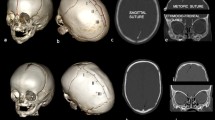Abstract
Purpose
The shape and size of the foramen magnum (FM) can be altered in craniosynostoses. However, few studies have investigated these changes. In this paper, we investigate the morphology of the foramen magnum in syndromic and non-syndromic brachycephaly.
Methods
Surface area, anteroposterior (AP) diameter, and transverse diameters of the FM were measured on high-resolution CT scans in children with Crouzon (25), Pfeiffer (21), Apert (26), Saethre–Chotzen (7) syndromes, and isolated bicoronal synostosis (9) and compared to an age-matched control group (30).
Results
A significantly smaller FM surface area was observed in Crouzon (6.3 ± 1.7 cm2) and Pfeiffer (6.4 ± 2.3 cm2) syndromes as compared to the control group (7.4 ± 1.3 cm2, p = 0.006 and p = .017, respectively). In comparison to the control group, no statistically significant alteration in FM surface area was noted in patients with Apert, Saethre–Chotzen, or isolated bicoronal synostosis (p = 0.37, p = 0.71, p = 0.40 respectively). The transverse diameter of FM was significantly smaller in Crouzon, Pfeiffer, and Apert syndromes compared to the control group (p = 0.005, p = 0.002, p = 0.03 respectively). In Saethre–Chotzen and isolated bicoronal synostosis, no difference in transverse diameter was demonstrated. Among all groups, only Crouzon syndrome showed reduced anteroposterior diameter as compared to controls (p = 0.005). In Pfeiffer and Apert syndromes, there was elongation of the shape of the FM with a relatively narrowed width as demonstrated in a significantly increased AP to transverse diameter ratio (p = 0.002 and p = 0.019, respectively).
Discussion and conclusions
The FM shape and area is significantly altered in fibroblast growth factor receptor (FGFR)-related brachycephaly syndromes (Crouzon, Pfeiffer, and Apert), whereas in patients with Saethre–Chotzen syndrome (TWIST-1 mutation) and isolated non-syndromic bicoronal synostosis, the shape and mean FM area was not statistically different from that of normals. This study brings to light the important role of FGFRs on FM growth and shape. TWIST-1 mutation (Saethre–Chotzen syndrome) does not appear to have an important effect in shaping the FM.






Similar content being viewed by others
References
Aviv RI, Rodger E, Hall CM (2002) Craniosynostosis. Clin Radiol 57:93–102
Hehr U, Muenke M (1999) Craniosynostosis syndromes: from genes to premature fusion of skull bones. Mol Genet Metab 68:139–151
Kimonis V, Gold J-A, Hoffman TL, Panchal J, Boyadjiev SA (2007) Genetics of craniosynostosis. Semin Pediatr Neurol 14:150–161
Agochukwu NB, Solomon BD, Muenke M (2012) Impact of genetics on the diagnosis and clinical management of syndromic craniosynostoses. Childs Nerv Syst 28:1447–1463
Howard TD, Paznekas WA, Green ED, Chiang LC, Ma N, De Luna RIO, Delgado CG, Gonzalez-Ramos M, Kline AD, Jabs EW (1997) Mutations in TWIST, a basic helix-loop-helix transcription factor, in Saethre-Chotzen syndrome. Nat Genet 15:36–41
Clauser L, Galie M, Hassanipour A, Calabrese O (2000) Saethre-Chotzen syndrome: review of the literature and report of a case. J Craniofac Surg 11:480–486
Katzen JT, McCarthy JG (2000) Syndromes involving craniosynostosis and midface hypoplasia. Otolaryngol Clin N Am 33:1257–1284
Paliga JT, Goldstein JA, Vossough A, Bartlett SP, Taylor JA (2014) Premature closure of the spheno-occipital synchondrosis in Pfeiffer syndrome: a link to midface hypoplasia. J Craniofac Surg 25:202–205
Tahiri Y, Paliga JT, Vossough A, Bartlett SP, Taylor JA (2014) The spheno-occipital synchondrosis fuses prematurely in patients with Crouzon syndrome and midface hypoplasia compared with age- and gender-matched controls. J Oral Maxillofac Surg 72:1173–1179
Kreiborg S, Marsh JL, Cohen MM, Liversage M, Pedersen H, Skovby F, Børgesen SE, Vannier MW (1993) Comparative three-dimensional analysis of CT-scans of the calvaria and cranial base in Apert and Crouzon syndromes. J Craniomaxillofac Surg 21:181–188
Goodrich JT (2005) Skull base growth in craniosynostosis. Childs Nerv Syst 21:871–879. doi:10.1007/s00381-004-1113-1
Milhorat TH, Nishikawa M, Kula RW, Dlugacz YD (2010) Mechanisms of cerebellar tonsil herniation in patients with Chiari malformations as guide to clinical management. Acta Neurochir (Wien) 152:1117–1127
Coll G, Arnaud E, Selek L, Brunelle F, Sainte-Rose C, Collet C, Di Rocco F (2012) The growth of the foramen magnum in Crouzon syndrome. Childs Nerv Syst 28:1525–1535
Di Rocco F, Dubravova D, Ziyadeh J, Sainte-Rose C, Collet C, Arnaud E (2014) The foramen magnum in isolated and syndromic brachycephaly. Childs Nerv Syst 30:165–172
Leikola J, Haapamäki V, Karppinen A, Koljonen V, Hukki J, Valanne L, Koivikko M (2012) Morphometric comparison of foramen magnum in non-syndromic craniosynostosis patients with or without Chiari I malformation. Acta Neurochir (Wien) 154:1809–1813
Huang R, Zhi Q, Patel K, Wilting J, Christ B (2000) Contribution of single somites to the skeleton and muscles of the occipital and cervical regions in avian embryos. Anat Embryol (Berl) 202:375–383
Di Ieva A, Bruner E, Haider T, Rodella L, Lee J, Cusimano M, Tschabitscher M (2014) Skull base embryology: a multidisciplinary review. Childs Nerv Syst 30:991–1000
Muhleman M, Charran O, Matusz P, Shoja MM, Tubbs RS, Loukas M (2012) The proatlas: a comprehensive review with clinical implications. Childs Nerv Syst 28:349–356
Nemzek WR, Brodie HA, Hecht ST, Chong BW, Babcook CJ, Seibert JA (2000) MR, CT, and plain film imaging of the developing skull base in fetal specimens. AJNR Am J Neuroradiol 21:1699–1706
Tubbs RS, Wellons JC 3rd, Blount JP, Grabb PA, Oakes WJ (2003) Inclination of the odontoid process in the pediatric Chiari I malformation. J Neurosurg 98:43–49
Richards GD, Jabbour RS (2011) Foramen magnum ontogeny in Homo sapiens: a functional matrix perspective. Anat Rec 294:199–216
Taylor WJ, Hayward RD, Lasjaunias P, Britto JA, Thompson DN, Jones BM, Evans RD (2001) Enigma of raised intracranial pressure in patients with complex craniosynostosis: the role of abnormal intracranial venous drainage. J Neurosurg 94:377–385
Conflict of interest
The authors report no conflicts of interest related to the contents of this paper and declare to have no funding for the underlying study.
Author information
Authors and Affiliations
Corresponding author
Rights and permissions
About this article
Cite this article
Assadsangabi, R., Hajmomenian, M., Bilaniuk, L.T. et al. Morphology of the foramen magnum in syndromic and non-syndromic brachycephaly. Childs Nerv Syst 31, 735–741 (2015). https://doi.org/10.1007/s00381-015-2639-0
Received:
Accepted:
Published:
Issue Date:
DOI: https://doi.org/10.1007/s00381-015-2639-0




